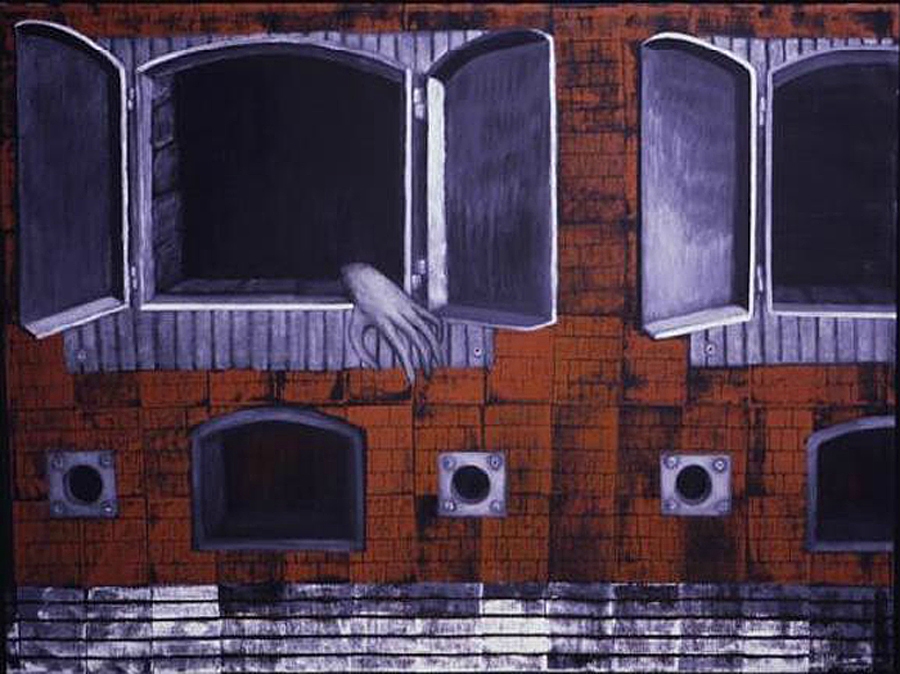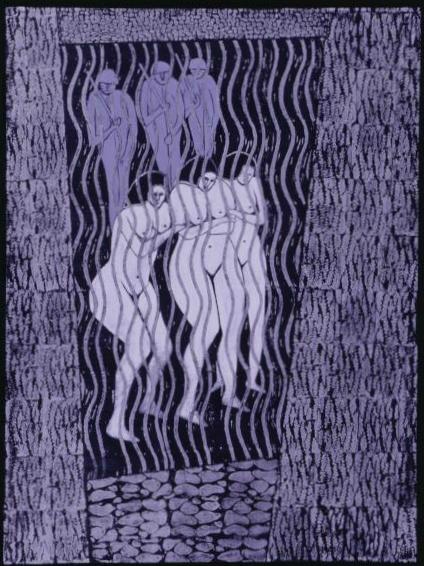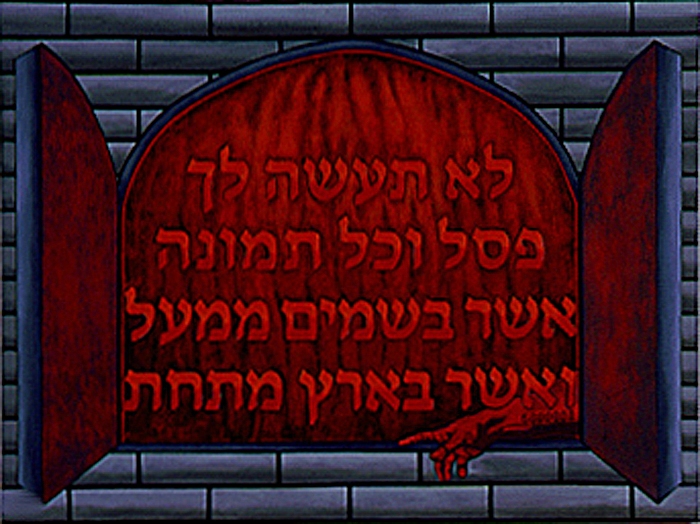Return to the Holocaust Paintings Gallery
Read about the Holocaust Paintings Series
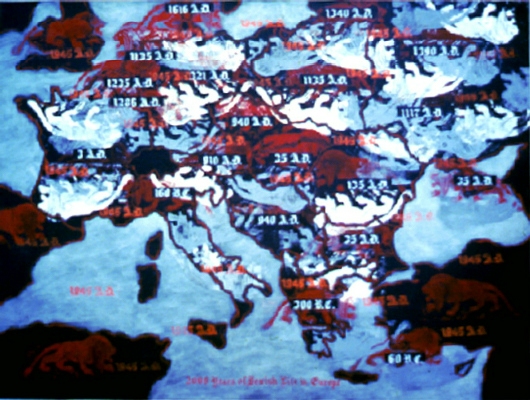
1. 2000 YEARS
Maps of the Holocaust 30"X40" Acrylic 1988This map depicts the destruction of two thousand years of Jewish life in Europe during World War II. The dates indicate when the Jewish communities in various countries were established. The image of the lion is used as a symbol of Jewish life.
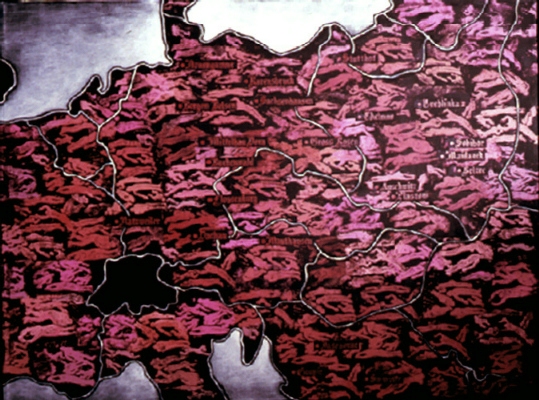
2. EUROPE 1945
Maps of the Holocaust 30"X40" Acrylic 1988This map portrays Europe as a graveyard at the end of World War II. Highlighted are some of the most notorious concentration camps, where millions lost their lives. The bodies strewn everywhere symbolize the mass slaughter perpetrated by the Nazis
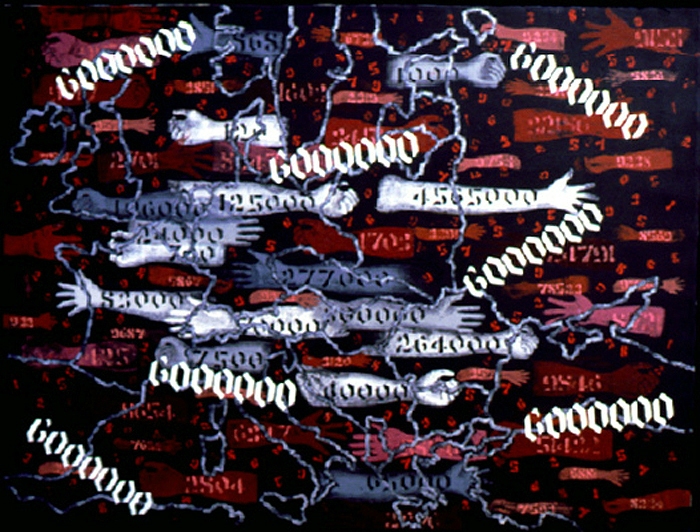
3. SIX MILLION
Maps of the Holocaust 30"X40" Acrylic 1988This map shows the number of Jews killed by the Nazis in each area of Europe during World War II. The large dismembered arms symbolize death, and the total number of Jews killed in each area is represented as a tattoo. The allusion is to the tattooed ID numbers with which the Nazis marked the arms of their victims.
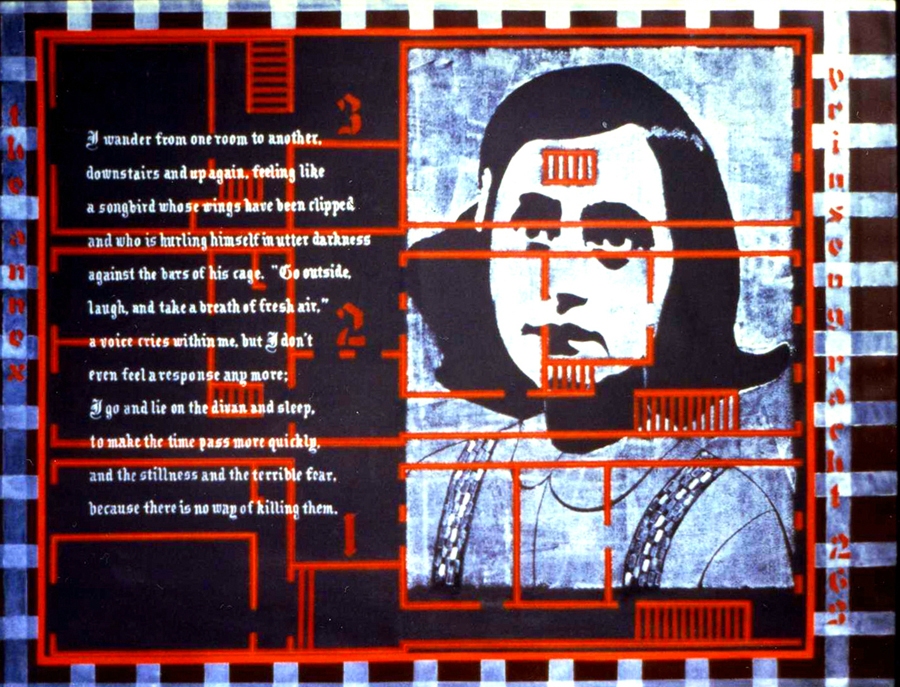
4. ANNE FRANK'S HIDING PLACE
Maps of the Holocaust 30"X40" Acrylic 1988Superimposed upon an image of Anne Frank is a floor plan of the Annex of the building in Amsterdam where she and her family hid from the Nazis and where she wrote her now-famous diary. The words from the diary, reproduced from an entry she made on October 29, 1943, are symbolized by the strong horizontals and verticals of the house plan, which form a cage-like structure within which Anne seems trapped.
5. ANNE FRANK'S AMSTERDAM
Maps of the Holocaust 30"X40" Acrylic 1988This map of Europe focuses on the destruction of two thousand years of Jewish life in Europe during World War II. The dates indicate when the Jewish communities destroyed in the Holocaust in various countries were established. The image of the lion is used as a symbol for the Jewish people. The red lion, the Lion of Judah full of life, shows that each community was established. The lion is gray and upside down to indicate that the community was destroyed.
The repeated image of the lion in the body of the work was block printed directly on the background fabric but was printed on swatches of fabric and then appliqued along the edges. The borders of the European countries were embroidered in gray cotton floss. The red beads scattered over the surface symbolize the bloodshed.
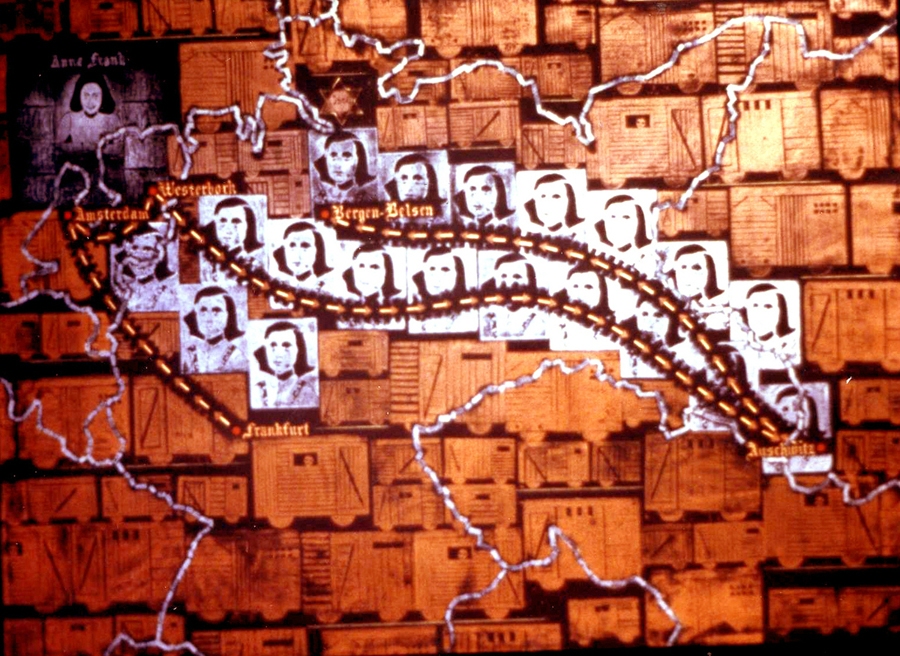
6. ANNE FRANK'S JOURNEY
Maps of the Holocaust 30"X40" Acrylic 1988Depicted here, against a background of constant trains, are the vast distances which a young girl, Anne Frank, traveled to her death. On the way from Frankfurt, her birthplace, through Amsterdam, where she lived for a number of years (and wrote her diary), to Westerbork and on to Auschwitz and finally to her death, Anne Frank's image becomes increasingly faint as she approaches her demise at the Bergen Belsen concentration camp.
7. CROSS (SIX DEATH CAMPS)
Maps of the Holocaust 72"X72" Acrylic 1996In this work, the layout of the six Nazi death camps - Auschwitz, Belzec, Chelmno, Majdanek, Sobibor and Treblinka - is presented in the form of a cross. The image of the cross inevitably raises the question: Where was God during the Holocaust?
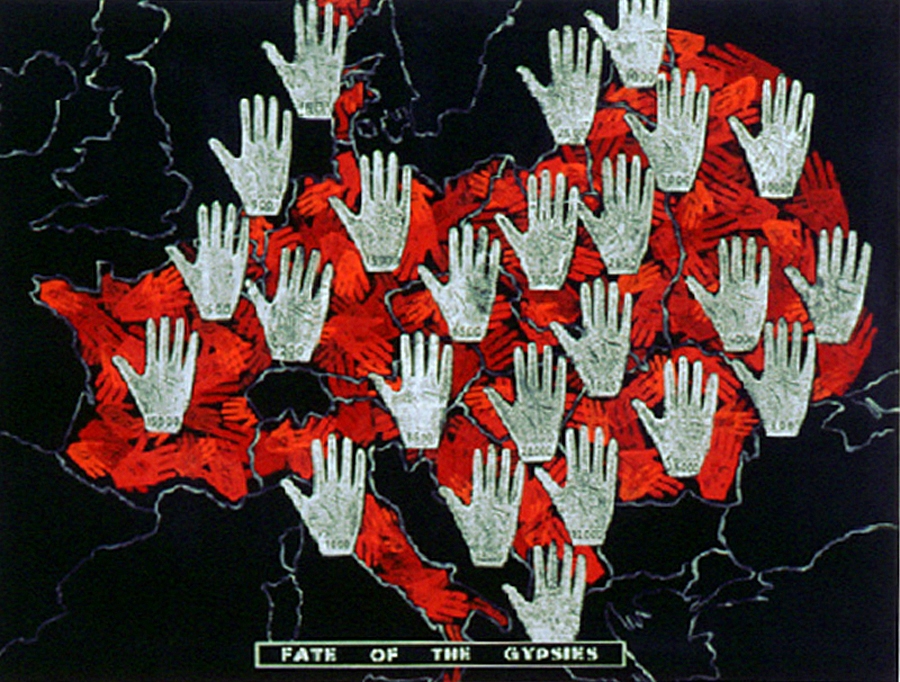
8. FATE OF THE GYPSIES
Maps of the Holocaust 30"X40" Acrylic 1996As part of their policy of ridding Europe of its Gypsies as well as of its Jews, the Nazis murdered at least 200,000 Gypsies (out of approximately 700,000 living in Europe in 1939). This map indicates the number of Gypsies who perished in various parts of Europe. The hand, traditionally used by the Gypsies to foretell the future of others, here symbolizes the Gypsies' own fate.
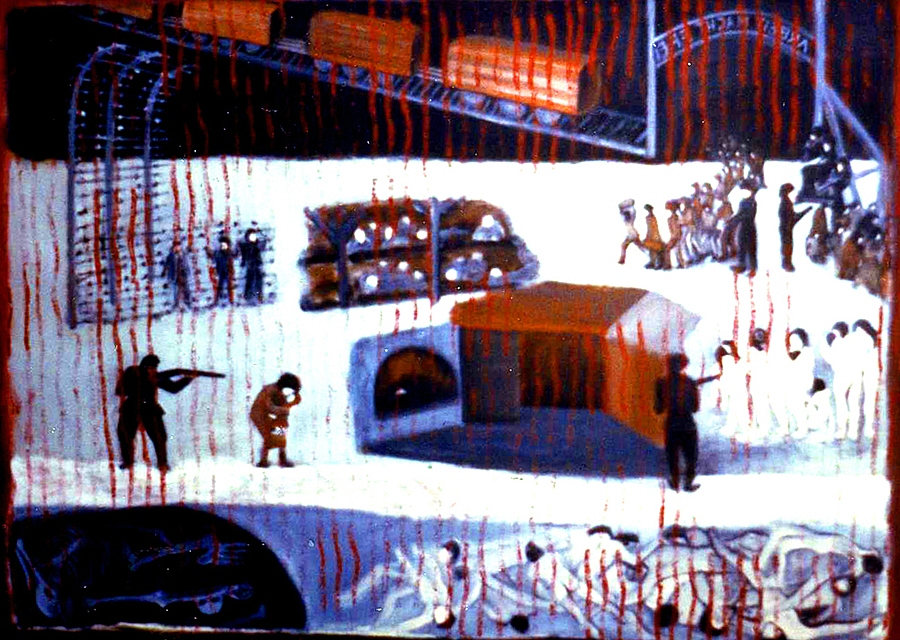
9. ARBEIT MACHT FREI
Scenes of the Holocaust 30"X40" Acrylic 1987This painting is a composite of scenes from the Holocaust: boxcars, people divided into lines of "life" and "death," fences, barbed wire, bunks, gas chambers, a crematorium, piles of corpses etc. The words "Arbeit Macht Frei" – "Work Liberates" – which appeared at the entrance of camps such as Auschwitz, were intended to conceal the true nature of the camp. This painting was the first Holocaust painting created by the artist and can be viewed as an introduction to the HOLOCAUST PAINTINGS series.
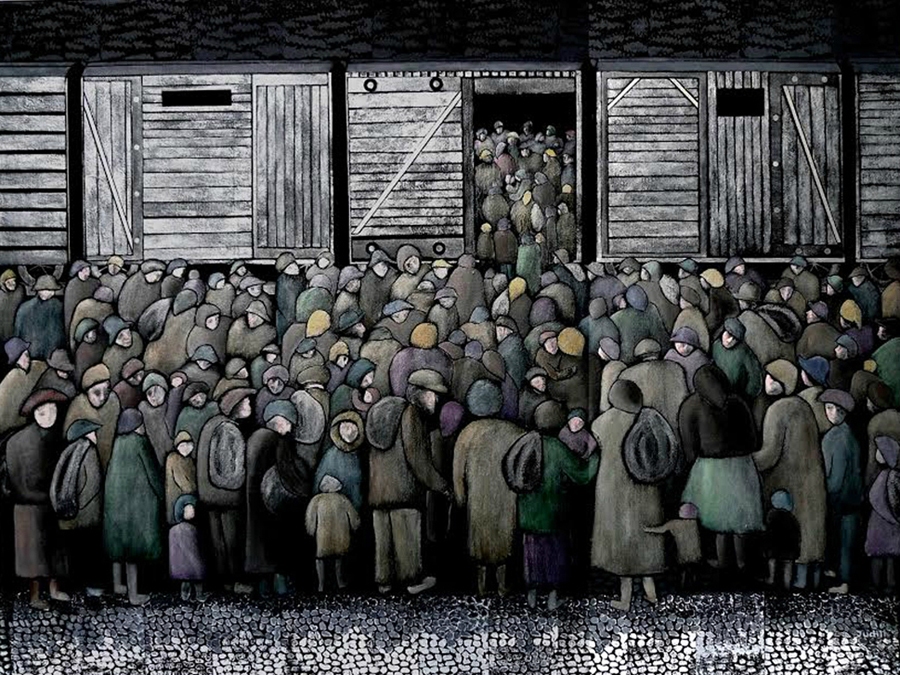
10. BOARDING
Scenes of the Holocaust 30"X40" Acrylic 1987In this painting, the scene is that of a mass of people about to board a train consisting of boxcars. The people as depicted are without facial features. This underscores the fact that human beings were treated by the Nazis like fungible commodities, with no respect for their individuality and humanity. The facelessness of the people also emphasizes the universality of their situation.
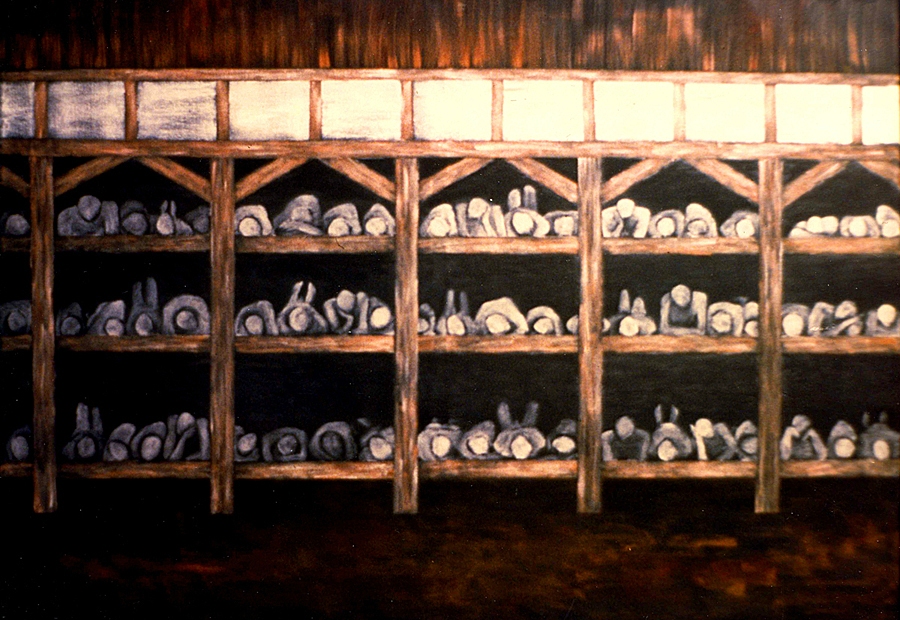
11. BUNKS
Scenes of the Holocaust 30"X40" Acrylic 1987Depicted against a massive structure of vertical poles and horizontal bunks are human beings so depersonalized that they seem to have lost all semblance of individuality. Clad in their uniformly striped prison garb, they lie crammed together in identical poses on level upon level of identical bunks, and uniformly stare at us with a gaze that is uniformly uncomprehending.
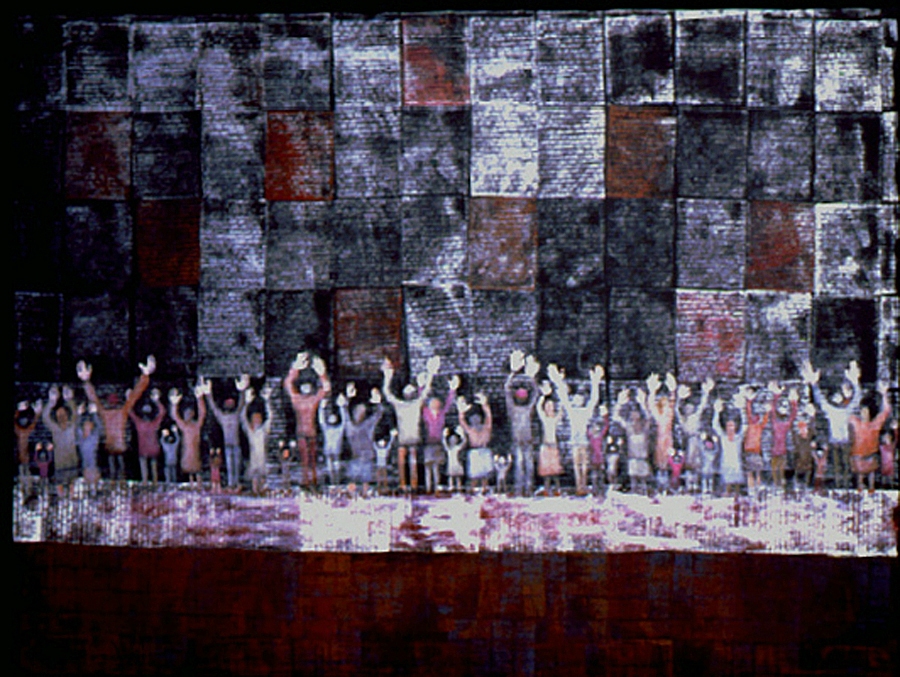
12. HANDS UP
Scenes of the Holocaust 30"X40" Acrylic 1987In this scene, men, women and children are standing facing away from the viewer and holding their hands up. Their gesture may symbolize submission or supplication, and the massive wall they are facing, while connoting no escape, is also reminiscent of the Wailing Wall. Perhaps at such a moment of despair, faith is the only way out.
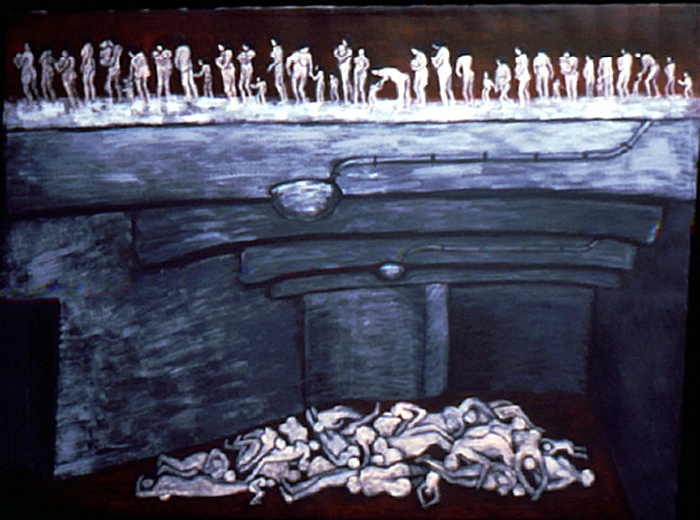
13. SHOWERS
Maps of the Holocaust 30"X40" Acrylic 1987"Showers" was the euphemism the Nazis used to lure camp inmates into the gas chambers. Along the upper portion of the painting, naked women and children are innocently walking toward the so-called showers. At the bottom, a pile of lifeless bodies shows the results of Nazi deception and cruelty.

14. THE CULPRIT
Scenes of the Holocaust 30"X40" Acrylic 1987This painting was inspired by a photograph from the Holocaust. It depicts a Nazi soldier aiming his gun at a defenseless woman and child. The composition and colors are intended to intensify the feeling of isolation of the victims.
15. THE HAND
Scenes of the Holocaust 30"X40" Acrylic 1987A hand protruding from an open crematorium symbolizes the anonymity with which the Nazis treated their victims in the Holocaust. In this image there is no indication of the age of the victim or the gender or any other aspect which would individualize the particular human being reaching out from inside the crematorium. The treatment of people as members of a mass rather than as individual human beings was at the core of Nazi atrocities.
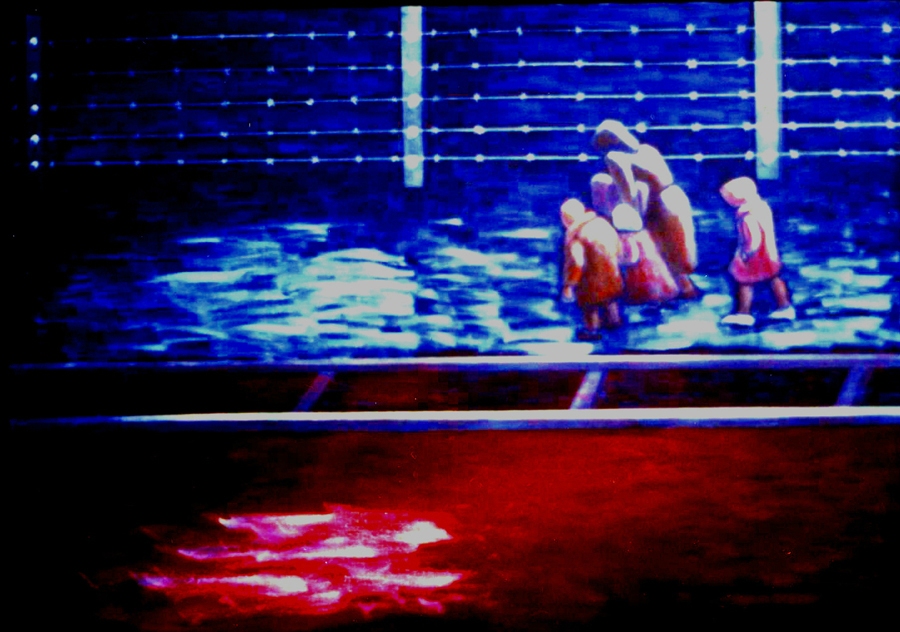
16. WHERE ARE WE GOING?
Scenes of the Holocaust 30"X40" Acrylic 1987This painting was inspired by a photograph from one of the camps, showing an old woman and her grandchildren on their way to the gas chambers. The composition and colors are intended to intensify the feeling of entrapment and isolation of this defenseless group.
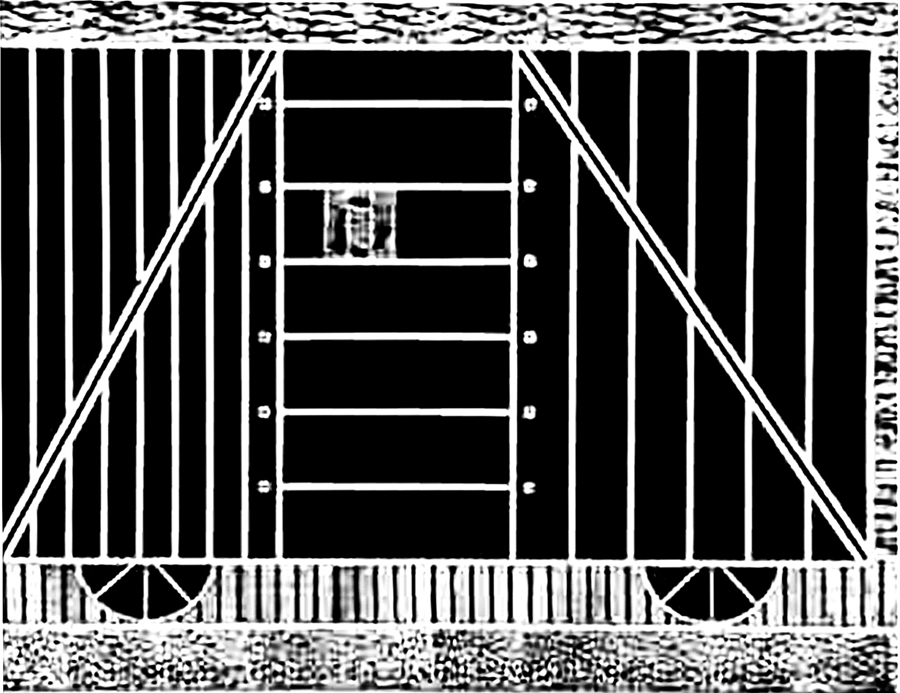
17. BOX CAR
Scenes of the Holocaust 30"X40" Acrylic 1987The box car depicted here symbolizes the vast network of trains which the Nazis used to deport people during World War II. The image in the window is that of Anne Frank, on her way from Holland to Auschwitz, or from Auschwitz to Bergen Belsen, where she perished. The box car and Anne Frank's image in it concretize the destiny of the millions whom the Nazis shipped in box cars to their deaths.
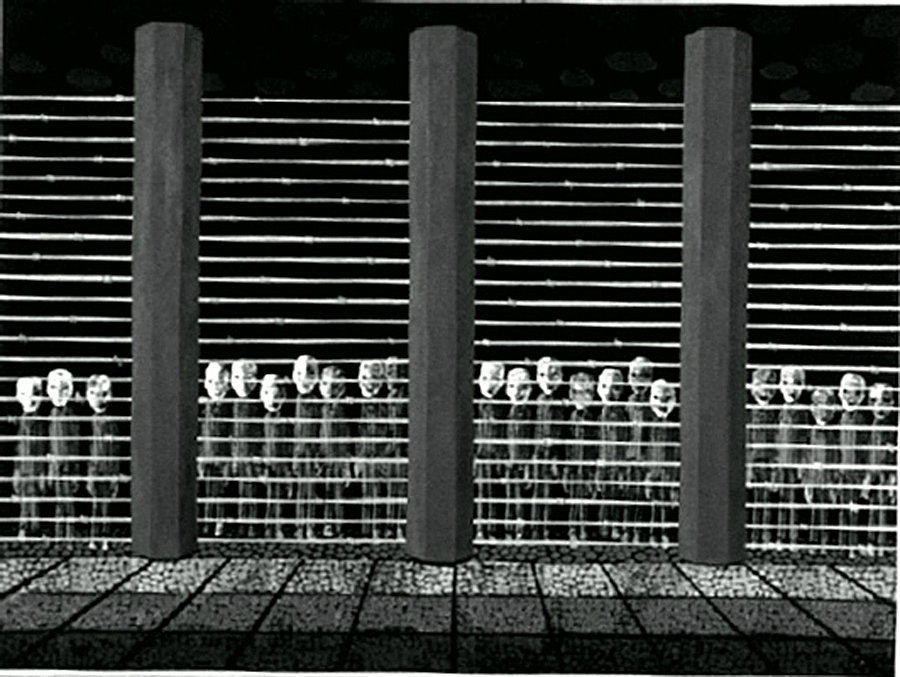
18. FENCED IN
Scenes of the Holocaust 30"X40" Acrylic 1987The prisoners standing behind the fence pose an enigma: Are they different from one another or are they all the same? Their depiction underscores the depersonalization that resulted from the Nazis' relentless pursuit of "efficiency" in their effort to bring about the so-called Final Solution.
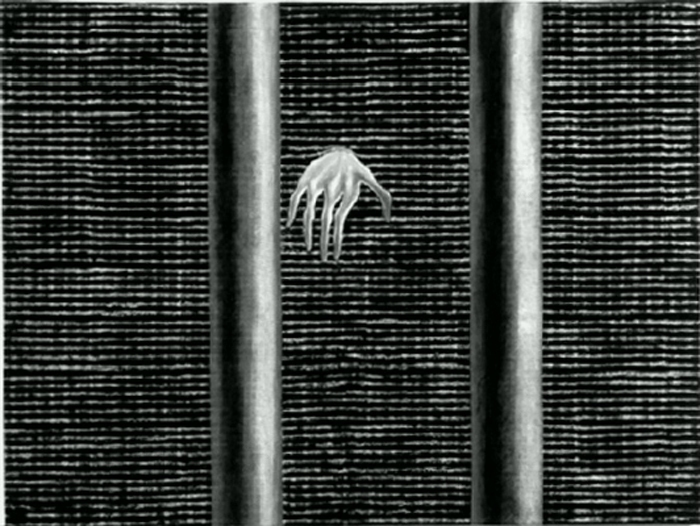
19. FROM THE OTHER SIDE
Scenes of the Holocaust 30"X40" Acrylic 1996From behind a fence, a human hand protrudes, groping, seeking, reaching. The disembodied hand symbolizes depersonalization and underscores the dehumanization that took place under Nazi rule.
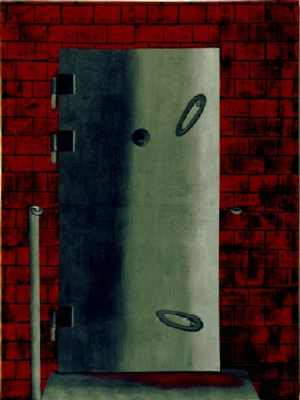
20. THE DOOR
Scenes of the Holocaust 40"X30" Acrylic 1996The door in this painting is patterned after a gas chamber door in one of the camps during the Holocaust. The small viewing window in the door enabled the Nazi guards to see if all the people in the gas chamber had succumbed. Until then, the door was kept sealed to prevent escape.
21. WOMEN IN THE HOLOCAUST
Epilogue 30"X40" Mixed media 2000This painting was inspired by photographs of women forced to walk naked to a place of execution during the reign of the Einsatzgruppen in Eastern Poland in 1941-1942. The composition is designed to convey the victims' feeling of entrapment and terror, and the black-and-white tonality represents the struggle between life and death.
22. IMAGES
Scenes of the Holocaust 30"X40" Acrylic 1989As befits the word of God expressed in the Torah, the words of the Second Commandment proscribing any "image of what is in the…earth" are here set against a backdrop which appears to be the interior of an ark. The open doors, however, quickly reveal that a ferocious fire is burning inside. The structure housing the words, it turns out, is not an ark but a crematorium. The image of the crematorium connects the scene to the Holocaust. A hand protrudes from the crematorium. The arm attached to that hand bears a "6000000" tattoo. This strengthens the association of the scene with the Shoah, as it is a reminder that six million Jews perished there.
The hand was patterned after God's hand in Michelangelo's The Creation of Adam. But while in Michelangelo's work God's hand is instrumental in giving life, in this painting it symbolizes death. Thus Images raises an artist's post-Auschwitz question about God: "Where was God during the Holocaust?" To put it bluntly, where was that all-knowing, all-powerful, loving God while six million Jews – and countless other innocent victims – were slaughtered? The answer suggested by Images is that millions of human beings were not the only victims of the Shoah. God's commandments and even God Himself perished in the Holocaust.
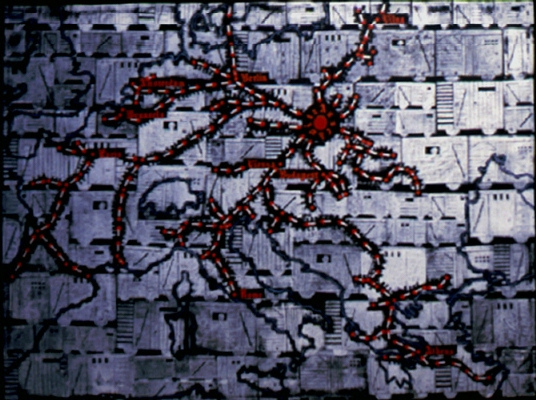
23. ROAD TO AUSCHWITZ
Maps of the Holocaust 30"X40" Acrylic 1988This map shows the many roads that led to Auschwitz, the most destructive of all the concentration camps. From North, South, East and West vast numbers were transported to their deaths there. The trains, which form the background, symbolize the methodical way in which the Nazis pursued their goal of a so-called Final Solution.






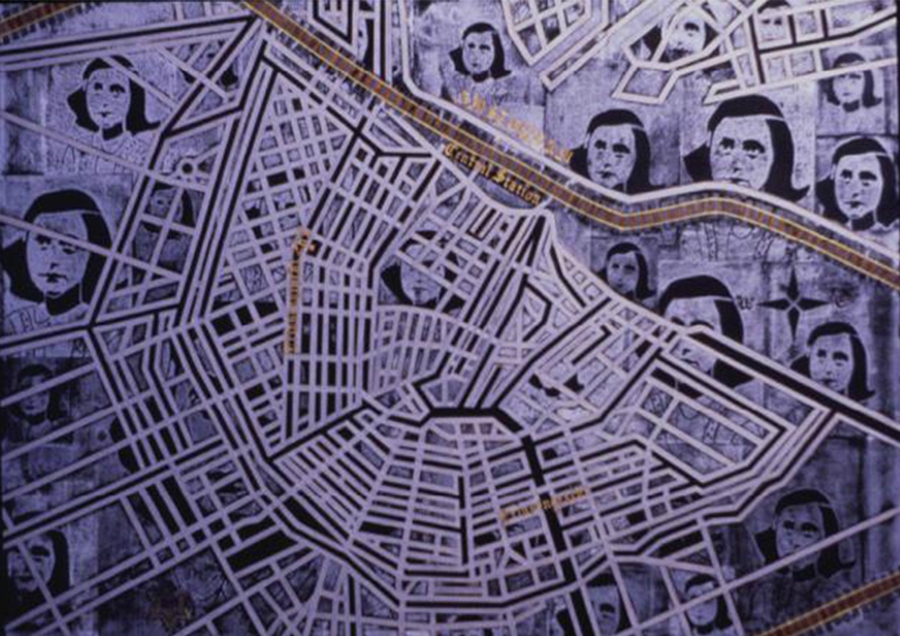
.JPG)
